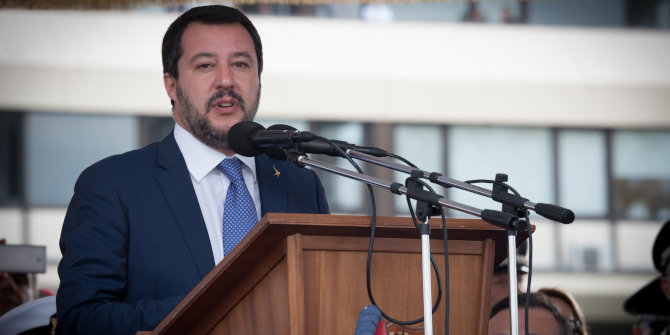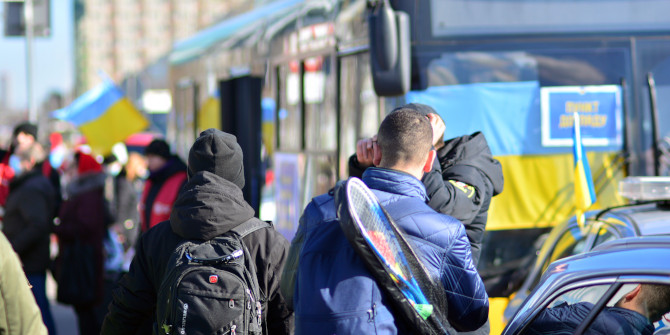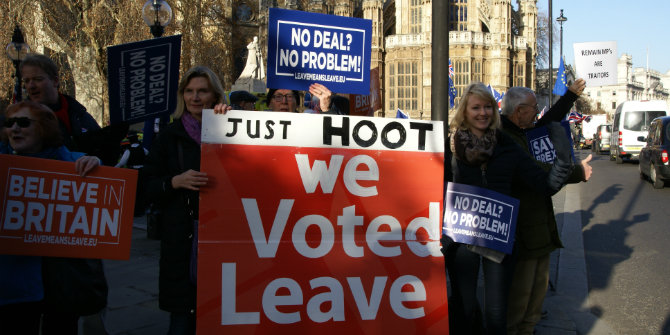From 22 May until 17 June, LSE will be hosting a new exhibition of work from Ukrainian artists and photographers. To mark the opening of the exhibition, EUROPP’s editor Stuart Brown spoke with Svitlana Biedarieva about how art is helping Ukrainians make sense of the war in their homeland.
Svitlana Biedarieva is a contributor to the At the Heart of War: Ukrainian resilience and resistance through art exhibition, on display as part of the LSE Festival from 22 May until 17 June 2023
How has Ukrainian art developed since the country’s independence in 1991?
Art in Ukraine, especially now at a time of war, reflects certain key processes that are ongoing in Ukrainian society. And moreover, art is also an impulse for such changes. In this sense, there is a kind of mutual connection and I would say that Ukrainian culture since 1991 has passed through several different stages of self-identification and disentanglement from the post-Soviet space, addressing the questions of contested memory, resistance through art, and identity construction, as I have discussed in my research. This process is visible in socially and politically engaged art practices and art activism. It is also present in the individual reflections of artists on the ongoing situation around them, notably during the current war with Russia.
In my recent work, I have shown that after 1991 Ukraine entered into a post-colonial condition, moving beyond historical narratives that were linked to Russian colonialism and reconsidering or recombining these perspectives into new narratives. In 2013-14, with the start of the Euromaidan protests and the beginning of war with Russia, we entered a new phase which had elements of a decolonial release, or a clearer break with the Russian cultural sphere. And now, since 2022 and the full-scale invasion of Ukraine, we have witnessed a complete decolonial break from the narratives of the past.
What impact has Russia’s invasion had on art and artists in Ukraine?
Since the invasion began, there has been an explosion in the production of new creative work and new approaches. Ukraine’s picture of the world completely changed because up until the last moment, nobody in Ukraine truly believed that Russia would initiate a full-scale invasion. In January 2022, for instance, I spoke with some Ukrainian artists as part of research I was conducting and no one I talked with genuinely thought that this could happen in such an aggressive way.
And I think that this shift in how Ukrainians thought about Russia has had a profound effect on Ukraine. The questions of Ukraine’s post-colonial condition, its historical narratives and the hybridity of its identity in relation to Russia have become secondary. Now we are seeing the creation of a completely new narrative focused on people’s experiences of war and the new history that is being formed in Ukraine.
One thing that Russia’s invasion has done is provide a sense of clarity. In 2017, as an artist, I worked on a project called The Morphology of War which focused on how society produces images of an enemy within the context of Russia’s hybrid war against Ukraine. With the escalation of Russia’s aggression, this project became more polarised. It now looks very unambiguous who the monsters are, and what the horrible results of their actions in Ukraine are.
How has art helped Ukrainian people make sense of the war?
Art is vital for making sense of the war in Ukraine. First, it can document the ongoing situation and not only deliver it to distant audiences that are not involved directly but also interpret it for these actors. This is one aspect. Another aspect is that art can give a voice to people that are affected by the war but would otherwise be unable to express themselves.
When we talk about the war in Ukraine, with all the violence and atrocities that Ukrainian society has witnessed, it is often impossible to explain the impact of everything that has happened using words alone. Art helps present these difficult and complex topics in a more simple but highly effective medium. I think this is also why we have seen such an increase in artistic work since the start of the invasion – artists feel the necessity to interpret what is happening and give an expression to the feelings of the people around them.
LSE will be hosting an exhibition of Ukrainian art and photography from 22 May until 17 June as part of this year’s LSE Festival. How significant is this exhibition and why should people visit it?
I think this exhibition is important for several reasons. First, it will give a platform for understanding Ukrainian art practices, with a focus on Ukrainian artists and photographers. Until recently, Ukrainian art was largely overlooked in western art spaces. There was a broad lack of interest in it and even when it was recognised that Ukrainian art could be highly interesting, there was a general lack of communication about it. This exhibition will help to remedy this.
Second, it is important precisely at this time of war to speak about Ukrainian art, culture and society. This is a chance for Ukrainian culture to be presented to the world and it is an opportunity for artists to establish a dialogue with international art spaces and international audiences.
Finally, I think it is particularly significant that we are presenting Ukrainian art at a university. A university is not an ordinary art space, where select groups of interested people visit an exhibition and applaud art based on its artistic merit. Hosting an exhibition at a university means it will be possible to bring in a far more diverse set of people, reaching out to students, academic staff and visitors. It will help to establish a wider dialogue about Ukrainian culture that encompasses a diversity of perspectives. For all these reasons, I think this exhibition will be of major importance.
At the Heart of War: Ukrainian resilience and resistance through art will be on display at LSE from 22 May until 17 June 2023 as part of the LSE Festival.
Note: This article gives the views of the interviewee, not the position of EUROPP – European Politics and Policy or the London School of Economics. Featured image credit: Svitlana Biedarieva






